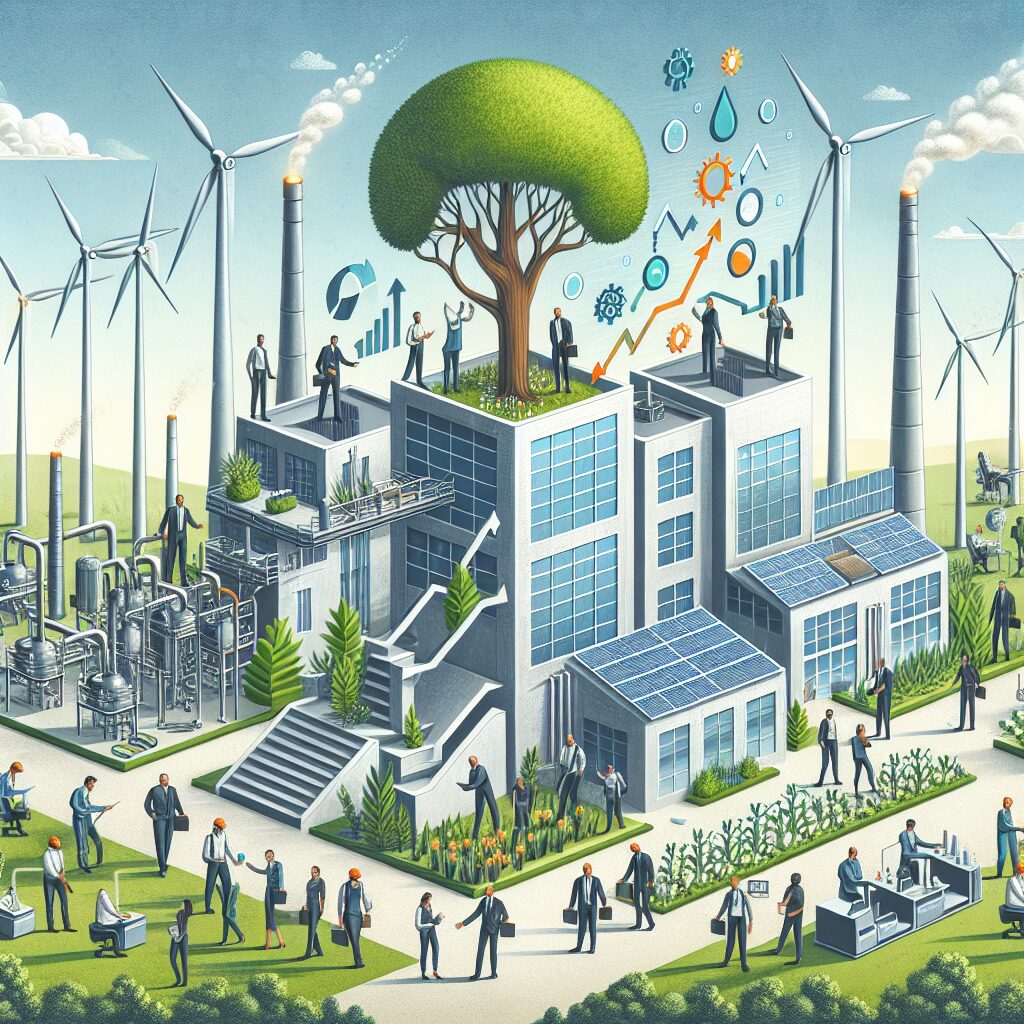Analyzing Key Drivers of Sustainable Industry Growth
The concept of sustainability has evolved from being a buzzword to an essential framework for businesses aiming for long-term success. In a rapidly changing global landscape, where environmental concerns, societal expectations, and economic imperatives intersect, industries must embrace sustainable growth strategies to remain competitive and relevant. Sustainable industry growth is not just about environmental conservation; it encompasses economic stability, social responsibility, and innovation. By analyzing the key drivers of sustainable industry growth, businesses can pave the way for a future that balances profit with purpose.

One of the most significant drivers of sustainable industry growth is innovation. Emerging technologies such as artificial intelligence (AI), blockchain, renewable energy solutions, and automation are reshaping the way industries operate. These advancements enable businesses to improve efficiency, reduce waste, and optimize resource utilization.
For example, the renewable energy sector has seen exponential growth due to innovations in solar panels, wind turbines, and energy storage systems. These technologies have made clean energy more accessible and affordable, reducing reliance on fossil fuels. Similarly, industries like agriculture are adopting precision farming technologies, such as drones and IoT sensors, to minimize resource wastage and enhance productivity.
The adoption of a circular economy mindset is another example of how innovation drives sustainability. Companies are now designing products with end-of-life recycling or reuse in mind, ensuring that materials remain in circulation longer. This approach not only reduces environmental impact but also creates new business opportunities.
Government policies and regulations play a pivotal role in steering industries toward sustainable growth. Across the globe, governments are implementing stricter environmental regulations, incentivizing green technologies, and setting ambitious carbon-neutral goals. These policies encourage businesses to adopt sustainable practices and invest in cleaner technologies.
For instance, the European Union’s Green Deal aims to make Europe the first climate-neutral continent by 2050. This comprehensive policy framework touches upon renewable energy, sustainable agriculture, and green transportation, among other sectors. Companies operating in the EU are now focusing on aligning their business strategies with these goals to remain compliant and competitive.
Similarly, carbon pricing mechanisms, such as carbon taxes and cap-and-trade systems, are compelling industries to account for their greenhouse gas emissions. These financial incentives push companies to reduce their carbon footprint, adopt cleaner energy sources, and innovate in environmentally friendly processes.
Consumer behavior is a powerful driver of sustainable industry growth. Modern consumers are increasingly aware of the environmental and social impact of their purchasing decisions. As a result, they are favoring brands that align with their values and demonstrate a commitment to sustainability.
This shift in consumer preferences has led to the rise of sustainable products, from eco-friendly packaging to ethically sourced goods. In the fashion industry, for example, brands like Patagonia and Stella McCartney have gained popularity by promoting sustainable practices, such as using recycled materials and ensuring fair labor conditions.
Moreover, certifications such as Fair Trade, organic, and LEED (Leadership in Energy and Environmental Design) have become important indicators for consumers seeking sustainable options. Companies that fail to adapt to these changing preferences risk losing market share, while those that embrace sustainability can build stronger customer loyalty and brand equity.
Environmental, Social, and Governance (ESG) metrics are increasingly becoming a standard for evaluating a company’s commitment to sustainability. Investors, stakeholders, and even employees are demanding greater transparency and accountability in how businesses approach sustainability.
Companies that actively integrate ESG principles into their operations often see long-term benefits, including improved financial performance and reduced risk. By addressing environmental concerns, promoting social equity, and maintaining robust governance practices, businesses can create value for all stakeholders.
For example, Unilever’s Sustainable Living Plan focuses on reducing environmental impact, improving health and well-being, and enhancing livelihoods across its supply chain. This commitment has not only strengthened Unilever’s reputation but also driven innovation and cost savings.
Sustainable industry growth often requires collective action. No single organization or industry can tackle global challenges like climate change, resource scarcity, or inequality alone. Cross-sector collaborations and partnerships are essential for driving large-scale change.
Public-private partnerships (PPPs) are a prime example of how collaboration can fuel sustainability. For instance, the United Nations’ Sustainable Development Goals (SDGs) have inspired various industries to work together toward common objectives. Companies, governments, and NGOs are joining forces to address issues such as clean water access, renewable energy adoption, and poverty alleviation.
Additionally, industry alliances like the Renewable Energy Buyers Alliance (REBA) are helping businesses transition to renewable energy by connecting them with clean energy suppliers. Such initiatives not only accelerate progress but also reduce costs and risks associated with sustainable transitions.
Resource efficiency is a cornerstone of sustainable industry growth. Businesses are increasingly recognizing the need to minimize waste, reduce energy consumption, and optimize the use of raw materials. This approach not only lowers costs but also mitigates environmental impact.
The concept of a circular economy takes resource efficiency a step further. Instead of the traditional linear model of “take, make, dispose,” a circular economy focuses on designing products and processes that enable materials to be reused, repaired, or recycled. Companies like IKEA and Adidas are embracing circular economy principles by offering repair services, creating products from recycled materials, and exploring innovative recycling methods.
By adopting resource-efficient practices and circular economy models, industries can reduce their dependency on finite resources and build resilience against supply chain disruptions.
Sustainable industry growth is not just about environmental considerations—it also involves fostering inclusive economic growth and workforce development. As industries evolve, there is a growing need to equip workers with the skills required for emerging roles in green technologies and sustainable practices.
Governments, educational institutions, and businesses are investing in workforce training programs to prepare for the future of work. For example, the energy sector is witnessing a surge in demand for professionals skilled in renewable energy technologies, energy efficiency, and sustainable engineering.
Inclusive growth also involves creating opportunities for marginalized communities and ensuring fair labor practices. Companies that prioritize diversity, equity, and inclusion (DEI) are better positioned to attract top talent, strengthen their brand reputation, and drive innovation.
In an era of climate change, geopolitical instability, and economic uncertainty, industries must prioritize resilience and risk management. Sustainable growth strategies help businesses navigate these challenges by reducing vulnerabilities and building adaptive capacity.
For example, companies that invest in renewable energy solutions are less exposed to fluctuations in fossil fuel prices. Similarly, businesses that adopt sustainable supply chain practices are better equipped to manage disruptions caused by natural disasters or geopolitical conflicts.
Resilience also extends to reputational risks. Companies that fail to address sustainability issues may face backlash from consumers, investors, and regulators. By proactively addressing these concerns, businesses can protect their brand and maintain stakeholder trust.
The role of data in driving sustainable industry growth cannot be overstated. Advanced analytics and big data tools are enabling businesses to monitor and optimize their environmental and social impacts more effectively.
For instance, energy management systems equipped with IoT sensors can track energy consumption in real-time, allowing businesses to identify inefficiencies and implement corrective measures. Similarly, supply chain analytics can help companies assess the environmental footprint of their operations and identify opportunities for improvement.
Data transparency is also crucial for building trust with stakeholders. By sharing accurate and verifiable data about their sustainability efforts, companies can demonstrate accountability and foster stronger relationships with investors, customers, and employees.
Ultimately, sustainable industry growth requires a cultural shift within organizations. Leadership commitment is critical for embedding sustainability into the core business strategy and fostering a culture of innovation and responsibility.
Leaders who prioritize sustainability set the tone for the entire organization, inspiring employees and stakeholders to align their actions with long-term goals. Companies like Tesla and Microsoft have demonstrated how visionary leadership can drive industry transformation, from accelerating the adoption of electric vehicles to committing to carbon negativity.
Employee engagement is another crucial aspect of cultural change. By empowering employees to contribute to sustainability initiatives, companies can harness their creativity and passion to drive meaningful progress.
Sustainable industry growth is a multidimensional challenge that requires a holistic approach. By focusing on key drivers such as innovation, regulatory compliance, consumer demand, corporate responsibility, and collaboration, industries can achieve a balance between economic success and environmental stewardship. The journey toward sustainability is not without challenges, but the rewards—resilient businesses, healthier ecosystems, and equitable societies—are well worth the effort. As industries continue to evolve, embracing these drivers will be essential for building a sustainable and prosperous future.
